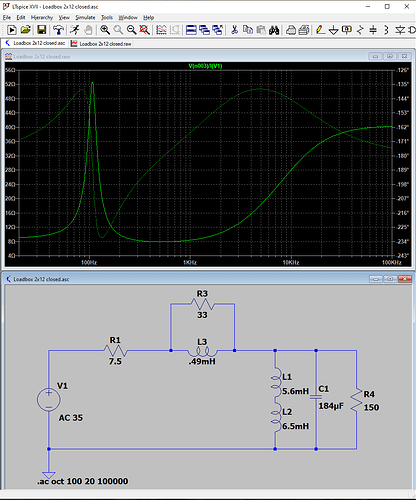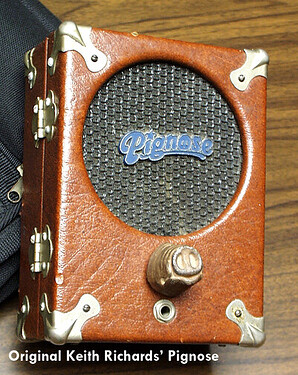In a pub rock band I used to be in, I used to play sax lines on some songs (that we will not mention now) on my Yamaha EX5, which had VL physical modelling on it. People wanted to know where we hid the sax player…
Yup - and given that my main job is keyboards, I already have to haul too much gear (88 keys, 61 keys, keyboard stand and all the paraphernalia… I’m happy that for those gigs where I also provide guitar parts, I simply add a guitar and a cable that plugs into my audio interface. And the sound is definitely good enough for my guitar skills ![]()
Now that I have the SWAM saxes in my arsenal, I love faking sax solos on my upper keyboard. It tends to divide the audience: some are completely fascinated (“where did that sax come from?”), while others (mostly saxophonists and “serious” keyboarders) want to stone me for blasphemy…
Depending on what type of material you play, the Orange low wattage heads are really nice. And small. And light. As are the low wattage Marshall heads. Check out Sonic Drive Studios on Youtube for plenty of examples of said amps thru quality IRs. Nice thing is those are easy to turn around if you buy and decide it isn’t for you. You might be out a few $ for an “extended demo” but can always get most of your $ back selling.
IMO, the place modelers are making hay is not so much in the amp sim piece, but in the cab sim and automation. People think you can just slap a 57 anywhere in front of a cab and you’re good to go for live. But as the thousands of free and horrible cab IRs on the net attest to, nothing could be further from the truth. They all sound horrible precisely because someone slapped a 57 or whatever in front of a cab/speaker in a lousy space and processed with a pedestrian signal chain.
The really good cab IRs (Ownhammer, Redwirez, Celestion) however, are another story entirely imo. They’re infinitely better than most live cab/mic setups imo. They don’t have any bleed into them, they use combinations of top shelf mics and signal chains mixed by someone that knows what they’re doing, they use top shelf cabs and speaker combinations recorded in an optimal space. Which is exactly why Fractal, Helix and others go to the top makers for their proprietary IRs.
So for me, tube amp beats the amp sims, and Cantabile with IRs and VSTs does the pieces that modelers excel at even better than they do.
As for aesthetics, it does look a bit odd with just a small head, two pedals and a convertible laptop. 
@sekim, I’m going to experiment with my little 5 watt tube amp and an IR. I’ve been checking out a Lancaster IR for the AC30. Like you I’m a big fan of the UCM203(4)HD audio interfaces. I think the preamp sounds very good with dynamic and condensor mics. I can track at low buffer settings with a fair amount going on also. I’ve never had any issue with the latest driver.
But…I did buy an IK Axe I/O Solo just to see if its “Guitar Input” (my name for input 1) improved things and I’m very happy with the “feel” of my Strat with its JFET circuit and changing the Z-Tone knob depending on what I’m doing (all the way left for Telecaster type bridge pickup sounds, past 1 oclock for neck pickup. If you ever get a chance to check one out I would be interested in your opinion of it.
EDIT: Forgot to mention it has an “Amp Out” for re-amping
The key to success is a good reactive load box. Without it, it won’t go well… I built mine and its great (let me know if you want the recipe). But for non DIYers, the Fractal is the best but is not in stock last I looked and extremely difficult to find on the used market. The Suhr is good but expensive. I’ve heard some of the cheapies, and was not impressed. YMMV, but that’s my experience…
I’m all over DIY, warming up iron right now  What’s the recipe for a DIY reactive load box?
What’s the recipe for a DIY reactive load box?
The design came from this thread:
I posted a bunch towards the end about mods I did for price/availability of the parts, but here is the synopsis in picture form (note the graph is an impedance plot, not a power plot):
For L1, L2 I’d strongly suggest a single inductor of 12mH. I was going to build a switchable box to do open back 1x12 closed 2x12 and closed 4x12 using multiple inductors but ditched the idea. This one is tuned for my 2x12 closed with G12T75 in it. The resonant reactive peak sits about half way between a typical open 1x12 and a closed 4x12. I tried both and could detect very little if any difference so landed here.
C1 is actually a pair of EARSE brand 92uF poly due to price/availability. .5uH is fine for L3. R3 was changed to 33ohm for tone reasons (less fizzy). Otherwise it’s the same circuit as the first post in the above thread modeled in LTSpice to use the slightly different parts due to availability/price…
The biggest things to be aware of are (1) layout is critical, the axis of the two inductors (the single L1+L2 and the L3) should be perpendicular, (2) the enclosure must be non-ferrous due to the inductors, (3) no ferrous parts should be close to the inductors. Reason being the values of the inductors will change dramatically if these rules aren’t followed, and consequently so will the response.
I bought the caps and inductors from EARSE, the rest from Mouser. The first post in the above thread shows the wattages needed for the resistors.
Also notice that I don’t show the audio out in the LTSpice model, so be sure to use what’s shown on the first post of the thread…
Enjoy, and feel free to ask questions. We can take them over to the above thread if its too far off topic here…
Also note that this is spec’d for a 100 watt amp running full power. So by all means you can use smaller wattage parts since your amp is 5 watts. However, lower wattage inductors have more resistance and therefor this needs to be accounted for. The easiest way is to just plug the resistance value of the inductors into LTSpice and make sure they don’t change the response too much or cause need for a slightly different value for R1. I can do that for you if you aren’t into LTSpice, just let me know…
Yes. Fortunately, I never had an irate sax player in the audience. 
Yamaha’s physical VL modelling was excellent (still is) and most of what we were doing was simple enough so it was fairly convincing on the keyboard and mod wheel. Would never have tried to pull off something like Baker Street, for example!
One of my bandmates uses an Orange. It is impressive for a small wattage amp.
I own a ton of the Ownhammer, and Celestion IRs. I use them all the time. ML is an up, and coming company, and I am really impressed with their IRs. ALSO, I found a guy who made IRs from all Neural DSP Cabs, and all I can say is OMG!!
I may have mentioned this on another thread a few years ago. But, while we are somewhat on the subject of small wattage amps…I went to see Chicago Transit Authority several times in the late 60s and early to mid 70s. Their amazing guitarist, Terry Kath (my favorite BTW), once used a Mic’d Pignose on stage.
The Pignose practice amp is a completely portable transistor amp weighing only 5 pounds and measuring 9 x 6 x 4". Pignose puts out about 3 watts R.M.S. (5 watts peak) into a 5-inch speaker and is powered by six AA batteries. I couldn’t believe the tone he got out of this thing. Of course, I later found out Chicago bought the company and was promoting the product. The trick to the tone was opening the hinged cabinet. Doing so cuts the bass and low-mids in half, creating an impression of screaming treble. Many guitarists used it as an amazing preamp.
I remember those! I almost bought one back in the day!
The Cali actually comes with separate IRs of the built in cabs. Cali has a performance issue with the cabs that is yet to be fixed and I suppose the IRs are a given as a work around. They don’t do that for any of the others… Their IRs are good…too bad you have to shoot them thru the plug if you want them, but that’s very easy to do if you want them separate. Just record a full amplitude single sample run thru just the cab sim, and you got it… If it clips just do it again with a smaller amplitude single sample.
It’s good to have the cabs separate of the individual plugin to try out.
I remember the Pignose. Those were a blast.
I found this video helpful for learning about both the Kemper and the the Quad Cortex. I thought the Quad Cortex “captures” were spot on tone wise.
Hi @sekim, thanx for pointing this out - wasn’t aware of it. The additional CPU load wasn’t so bad on my systems, but deactivating the cab sim and using an external IR loader seems to reduce the load a bit. And every little bit helps…
The build shown on the first page of the above link (Aiken’s Reactive Dummy Load) is beautiful. Will running a 5 watt load into that build work?
I’ve always dug the Orange sound a lot. Might check out what the Micro Terror could do. Frankly I don’t want to spend any more than that; I’m getting good sounds out of the modelling stuff.
Absolutely! Its no different than turning a bigger amp down… So, either build the one described on the first post using the parts he says, or build the one I describe that performs identically but uses alternate parts due to price/availability. Or spec lower wattage parts and plug the inductor resistance into LTSpice and make adjustments as needed. The internal resistance of the inductors is a published spec, btw.
Just follow the rules about placing the inductors on perpendicular axis and as far apart as feasible and do not use a ferrous case or any ferrous parts close to the inductors. If you have a multimeter that measures inductance, you can see a massive change in value if, for example you use a ferrous screw in the center of the air-core inductor to mount it. Plenty in the pages of that thread about that, lol.
As for me, I’m strong in analog design of semiconductors and tubes, but had never worked with high wattage passives that included inductors. So while prototyping my switchable design, I soldered the pieces together, placed them on a small piece of plywood, then hooked them to a solid state reference amp to measure the impedance curve under a 50 watt power scenario. LOL, I failed to think thru that placing two inductors side by side creates an air gap transformer…lol, and found myself repairing the reference amp immediately after the first test! It was at that point I ditched the idea of a switchable design to do open back and closed back. Especially after trying both with the “wrong” cab…I really couldn’t tell a difference and I’m about as picky as they get… As for the toasted reference amp, fortunately it had internal fuses as well as the usual external fuse (pfew!).


